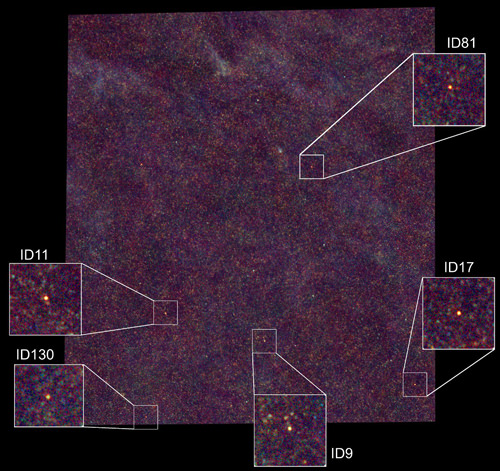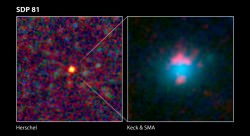[/caption]
One of the predictions of Einstein’s predictions from general relativity was that gravity could distort space itself and potentially, act as a lens. This was spectacularly confirmed in 1919 when, during a solar eclipse, Arthur Eddington observed stars near the Sun were distorted from their predicted positions. In 1979, this effect was discovered at much further distances when astronomers found it to distort the image of a distant quasar, making one appear as two. Several other such cases have been discovered since then, but these instances of gravitational lensing have proven difficult to find. Searches for them have had a low success rate in which less than 10% of candidates are confirmed as gravitational lenses. But a new method using data from Herschel may help astronomers discover many more of these rare occurrences.
The Herschel telescope is one of the many space telescopes currently in use and explores the portion of the spectrum from the far infrared to the submillimeter regime. A portion of its mission is to produce a large survey of the sky resulting in the Herschel ATLAS project which will take deep images of over 550 square degrees of the sky.
While Herschel explores this portion of the electromagnetic spectrum in far greater detail than its predecessors, in many ways, there’s not much to see. Stars emit only very faintly in this range. The most promising targets are warm gas and dust which are better emitters, but also far more diffuse. But it’s this combination of facts that will allow Herschel to potentially discover new lenses with improved efficiency.
The reason is that, although galaxies lack strong emission in this regime in the modern universe, ancient galaxies gave off far more since during the first 4 billion years. During that time, many galaxies were dominated by dust being warmed by star formation. Yet due to their distance, they too should be faint… Unless a gravitational lens gets in the way. Thus, the majority of small, point-like sources in the ALTAS collection are likely to be lensed galaxies. As Dr Mattia Negrello, of the Open University and lead researcher of the study explains, “The big breakthrough is that we have discovered that many of the brightest sources are being magnified by lenses, which means that we no longer have to rely on the rather inefficient methods of finding lenses which are used at visible and radio wavelengths.”
Already, this new technique has turned up at least five strong candidates. A paper, to be published in the current issue of Science discusses them. Each of them received followup observations from the Z-Spec spectrometer on the California Institute of Technology Submillimeter Observatory. The furthest of these these objects, labeled as ID81, showed a prominent IR spectral line had a redshift of 3.04, putting it at a distance of 11.5 billion lightyears. Additionally, each system showed the spectral profile of the foreground galaxy, demonstrating that the combined light received was indeed two galaxies and the bright component was a gravitational lens.
This method of using gravitational lenses will allow the Herschel team to probe distant galaxies in detail never before achieved. As with all telescopes, longer wavelengths of observations result in less resolution which means that, even if one of the distant systems were to be broken into distinct portions, Herschel would be unable to resolve them. But the fact that we can see them at all means their spectral signatures of the galaxies as a whole can still be studied. Additionally, as Professor Steve Eales from Cardiff University and the other leader of the survey noted: “We can also use this technique to study the lenses themselves.” This potential to explore the mass of the nearby galaxies may help astronomers to understand and constrain the enigmatic Dark Matter that makes up ~80% of the mass in our universe.
Dr Loretta Dunne of Nottingham University and joint-leader of the Herschel-ATLAS survey adds, “What we’ve seen so far is just the tip of the iceberg. Wide area surveys are essential for finding these rare events and since Herschel has only covered one thirtieth of the entire Herschel-ATLAS area so far, we expect to discover hundreds of lenses once we have all the data. Once found, we can probe the early Universe on the same physical scales as we can in galaxies next door.”



Is the gravitating galaxy in the foreground identified by other means? This is an interesting spin off discovery by a spacecraft dedicated to a much more local astronomy.
LC
Lawrence, the foreground galaxies are shown to be independent in both their spectra (as mentioned) and in many of the cases, it seems that they’ve been directly imaged (as the second image in the post displays).
Why would the wavelength/resolution matter? Once you identify the lens, can’t you follow up with other instruments?
I suppose I did not read the caption on the side picture. I have access to AAAS “Science” papers. What is a bit strange is that the impact parameter for this lens appears to be very large in comparison to the dimensions of the gravitational lense.
LC
@CrazyEddieBlogger: You’re right that you can follow up. That’s why I was careful to note only that “HERSCHEL would be unable to resolve them.” By using shorter wavelengths, it becomes easier to resolve, which is why Keck and other optical scopes were used.
@Lawrence: Remember that galaxies are significantly bigger than they appear from the luminous matter due to dark matter halos.
Isn’t it interesting how opening one door eventually leads to opening other unforeseen doors?
How does dark matter change Einstein’s equations concerning the mass required to bend light? In other words, assuming dark matter is present, then the lensed object might appear closer then it actually is due to the increased magnification of the lensing object? Right?
The bending of light is a measure of the mass of the gravity field. This in effect is how we measure the mass of DM.
LC